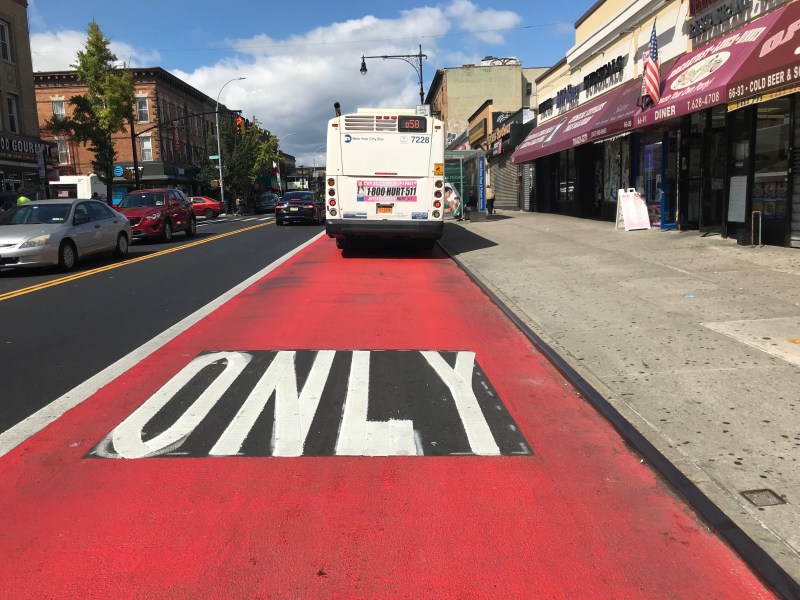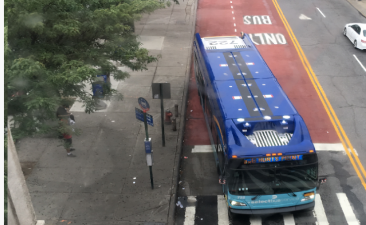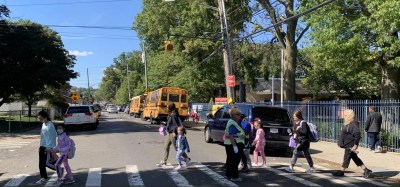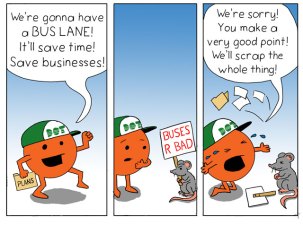ANOTHER TRANSIT DEBACLE: DOT Guts Its Own Bus Lane Project

The Department of Transportation has bowed to Staten Island car owners who objected to a bus lane project — the second high-profile pullback from a supposed commitment to help long-suffering transit riders in as many weeks.
Fresh on the heels of the suspension of a car-free busway project in Flushing, the DOT capitulated to two car-obsessed Staten Island council members and scaled back a much-hyped proposal to add dedicated bus lanes in both directions on a 3.3-mile stretch of Hylan Boulevard, as first reported by the Staten Island Advance.
Instead of bus lanes on both side of Hylan between Lincoln and Nelson avenues, the plan now calls for a 1.4-mile bus lane on the south side of Hylan, between Lincoln and Guyon avenues.
It’s a nearly 30-percent cut in lane miles for the project, which was part of 20 miles of busways and bus lanes that were announced with much enthusiasm by the mayor in June. At that time, the mayor promised that the first busway, a car-free .3-mile stretch in Flushing, would be created by the end of that month, but that plan was suspended indefinitely after Council Member Peter Koo claimed, in racially supercharged language, that the busway would hurt local businesses — a myth dispelled by DOT’s own statistics.
Activists were more than just disappointed.
“Mayor de Blasio promised bus riders 20 miles of new, COVID-era bus lanes and busways by October. He didn’t go so far as the MTA wanted with 60 miles, but he gave his hard commitment to put riders first on 20 miles of crowded city streets. Fully one-third of that mileage was planned for Hylan Boulevard,” said Danny Pearlstein of Riders Alliance.
“To meet the mayor’s target, ambitious in the context of prior City bus improvements, DOT must expedite its usual process of hand-holding and massaging the ego of every possible parochial project opponent,” he added. “DOT has at least a dozen years of anticipating and accommodating legitimate concerns. Officials shouldn’t reinvent the wheel each time they paint a lane.”
Like Koo, Council Members Steven Matteo and Joe Borelli argued that the DOT is not listening to the needs of its constituents — though bus riders are also voters in the districts in question. The council members put out a joint statement that is at once perfectly logical (arguing, for example, that much remains unknown about how people will commute after the pandemic) and also completely nonsensical (the same can be said for driving patterns, too, so perhaps DOT should remove cars entirely from Hylan).
Good Old #StatenIsland – Complain About Poor Public Transit, Fight Every Effort To Improve It. @StreetsblogNYC https://t.co/fSRm54phWr
— Rob Foran? (@Aunt_Bike) August 14, 2020
“It is nearly impossible to say whether this [proposed bus lane] is an improvement or not because … we simply do not know what traffic patterns and street usage will be when (and if) drivers and commuters return to pre-pandemic routines,” the councilmen wrote. “This administration has delayed hundreds of important projects due to the uncertainty caused by the ongoing COVID crisis — so we are puzzled as to why they are so intent to push this one forward without this vital information.”
The Department of Transportation strongly pushed back on the notion that it had caved to car owners’ concerns.
“Contrary to published reports, the alteration to the Hylan Boulevard lane was the result of a collaborative effort with our commuters,” DOT’s Staten Island Commissioner Tom Cocola told Streetsblog in a statement. “It was not the result of a pushback. Instead, on July 15, when DOT and MTA officials first presented the proposal to our Community Advisory Board, citizen Filippa Grisafi, a commuter and one of the leading express bus advocates on Staten Island, recommended that we change the southbound site to Guyon Avenue, because our data supported it.
“We said we would listen to our bus riders and so we announced this alteration at our second meeting this week. We decided that the northbound site should start at Nelson Avenue and extend to meet the existing lane at Lincoln Avenue. The northbound lane is important to commuters because they obviously are using this lane in the morning to get to work,” Cocola added.
The full Hylan Boulevard bus lane was expected to help speed trips along a crucial corridor for 32,500 weekday riders using the 11 bus routes on the stretch. The stretch between Lincoln and Guyson avenues is considered the most important stretch for a dedicated bus lane because bus speeds along that stretch are 23 to 40 percent slower than the rest of the route.
Borelli told Streetsblog on Friday that his real concern was the loss of parking spaces for businesses along Hylan Boulevard, and that his advocacy for car owners on Staten Island had been addressed.
But he also argued that the bus lane isn’t needed because bus ridership remains far below pre-pandemic levels even as car traffic on Staten Island has returned to its normal pre-pandemic gridlock. (The bus lane would only be off-limits to cars from 6 a.m. to 9 a.m. northbound and from 3 p.m. to 7 p.m. southbound — the exact times when better transit is necessary to reduce car trips.)
Streetsblog asked Borelli point blank: “Now that traffic is as bad as it’s always been, isn’t it time to beef up transit before there’s complete gridlock? Isn’t traffic a constant complaint on the Rock — and isn’t transit one solution?”
Borelli’s response? “For now people seem most comfortable using their cars,” he said. (Borelli’s personal comfort with his car is well documented: he has six speed-camera violations on his record, the most recent on July 8, according to city data.)
Activists pushed back on the council member’s argument that buses need to get out of the way of cars.
“Congestion along Hylan Boulevard impacts 30,000-plus bus riders every single day,” said Joe Cutrufo of Transportation Alternatives. “These are healthcare workers, teachers, municipal employees — the people who keep New York City running. Don’t they deserve a fast, reliable commute?”
People did praise him, but guardedly, and everyone knew he didn't have the courage to see any of these plans through. We've all been proven right. What a Pyrrhic victory.
— Second Ave. Sagas (@2AvSagas) August 14, 2020
And Ben Fried of TransitCenter made it clear that the problem is lack of will from the mayor.
“This all starts with Mayor de Blasio,” he said. “When the mayor gives DOT the mandate to put bus riders first, good things happen. Mayor de Blasio has to buck up and get the rest of these busway projects over the hump. These political spats will seem silly once people see the projects in action, just like 14th Street.”
Pearlstein of Riders Alliance also pointed out that the city has facts on the ground.
“Living proof abounds: Bus lanes and busways are good for riders, they’re good for business, and they’re good for communities across the city,” he said. “With the more ambitious Streets Master Plan law taking effect soon, mandating 30 new bus lanes miles each year for five years, DOT and City Hall need to significantly up their game. They can start by ignoring the haters.”
Of the lanes mentioned in the mayor’s June announcement, DOT has installed only the promised short stretches on East 14th Street and 149th Street in The Bronx.
It is unclear how well Staten Island residents would have honored the bus lane — the DOT never planned to put down red paint or enforce the lane with cameras, both of which have been shown to deter drivers from entering dedicated bus lanes.
This is a breaking story. We will update when we hear back from DOT.


